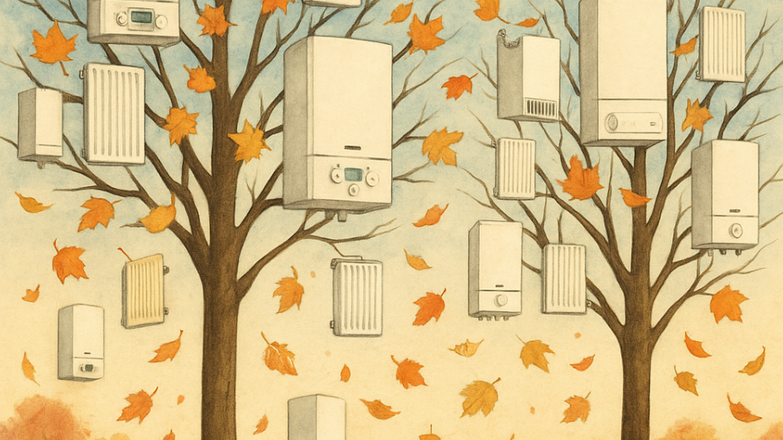
Dubbed a false autumn, this phenomenon occurs when prolonged heat and drought force trees to shed leaves prematurely in an attempt to survive. It’s not nature getting ahead; it’s nature struggling to keep up.
Early climate stress = early property risk
As seasons become less predictable, so too do the demands on our buildings. False autumn may start in the treetops, but its effects cascade into the built environment — particularly in rented properties where maintenance is often scheduled tightly against seasonal expectations.
Properties are already suffering from:
- Blocked gutters and drains as leaves fall early and rainfall hasn’t yet arrived to flush systems clean.
- Pest ingress increases as insects and rodents move indoors earlier than expected.
- Condensation and mould risks are rising as tenants switch on heating while ventilation remains inadequate.
- Heating systems are coming under strain before annual services have taken place.
- Increased reactive repair requests, especially as energy costs pressure tenants to delay heating use, then escalate issues when problems arise.
The practical upshot? The traditional October window for winter readiness no longer holds.
Tenant experience is also on the line
An overlooked boiler or slow response to heating issues goes beyond maintenance; it’s a service failure. In a competitive rental market, poor winter preparedness can damage agent reputations and reduce renewal rates. With tenants more inclined to move on, early planning becomes more than sound asset management; it’s a retention strategy.
Proactive communication - on what tenants can expect, how to report issues early, and the steps being taken to winter-proof their home — helps build trust and reduces last-minute pressure later in the season.
Legal responsibilities remain, even as the timelines shift
Under Section 11 of the Landlord and Tenant Act 1985, landlords remain responsible for keeping installations for the supply of water, gas, electricity, and heating in good repair. That duty doesn’t adjust based on shifting seasons. If cold conditions arrive ahead of schedule, so does the urgency to comply.
Agents should ensure their landlords are prepared for compressed timelines and increased demand on contractors. Having winter maintenance plans in place (alongside clear documentation of inspections and communication) strengthens the ability to demonstrate compliance and mitigate disputes.
The case for accelerated seasonal planning
Agents and landlords now need to manage their portfolios with greater flexibility. Reactive maintenance is no longer a fallback; it’s fast becoming a liability.
Recommended actions:
- Bring forward boiler servicing and heating system checks. Booking delays are already common.
- Schedule gutter and roof inspections to prevent blockages and water ingress.
- Review insulation and draught-proofing before tenants start reporting cold-related issues.
- Strengthen tenant communications on heating use, ventilation, and early issue reporting.
- Use digital tools to automate seasonal checks, track maintenance tasks, and respond more effectively to environmental shifts.
Planning for uncertain seasons
False autumn is unlikely to be a one-off. The UK is facing increasing volatility in seasonal patterns: drier springs, wetter winters, hotter summers, and unpredictable transitions.
Property professionals will need to move away from rigid seasonal schedules and instead respond dynamically to what the environment is already showing. That means:
- Forecast-based scheduling
- Predictive analytics to identify vulnerable assets
- Automated tenant updates and alerts
- Inspection tools that tag, log, and monitor environmental damage over time
Platforms like Inventory Base are already enabling this shift—helping agents and landlords act faster and smarter in changing conditions.
Looking ahead
This year’s early leaf-fall isn’t cosmetic. It’s an operational warning. The impact of false autumn on buildings, systems, and tenancy management will increase if planning continues to rely on traditional seasonal markers.
Agents and landlords who take early, informed action will be better positioned to:
- Protect portfolios from preventable issues
- Meet legal and service obligations under pressure
- Strengthen tenant trust and retention
- Avoid repair bottlenecks and reputational damage as winter sets in
False autumn may feel premature, but failing to act will be the real delay.
InventoryBase: Property inspection software
Our multi-award winning software has been designed to work with the residential and lettings market and built to provide Propertymark members with intuitive and responsive property reporting options across all systems and devices.





